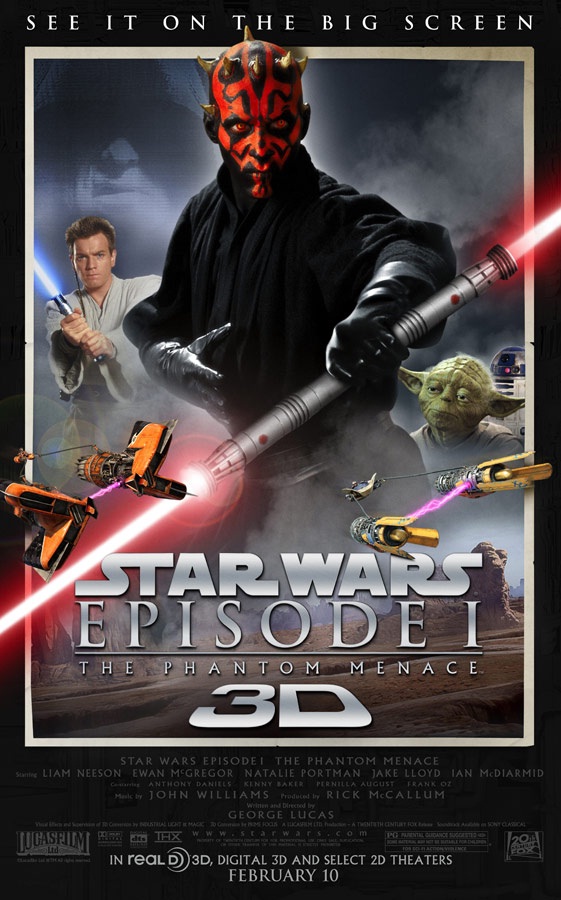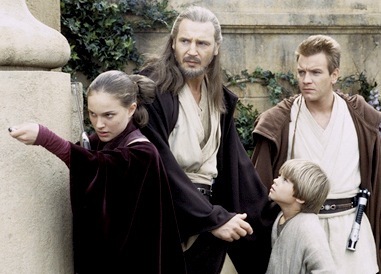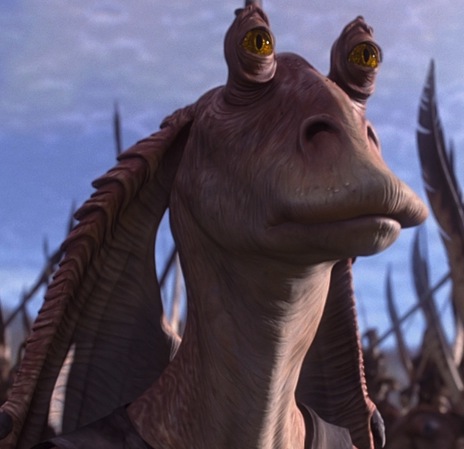 May 19, 1999 saw the release of, quite possibly, the most anticipated movie of all time. Fever for Star Wars: Episode I – The Phantom Menace was hitting new highs leading up to the unleashing of TPM. People were taking drastic measures, camping out for weeks just to be among the first to glimpse at an all new installment of Star Wars. Then it hit theaters—and reactions were all over the place. Some genuinely enjoyed it. Some tried their best to feign a smile, harboring their despair for years. Some just went for the jugular.
May 19, 1999 saw the release of, quite possibly, the most anticipated movie of all time. Fever for Star Wars: Episode I – The Phantom Menace was hitting new highs leading up to the unleashing of TPM. People were taking drastic measures, camping out for weeks just to be among the first to glimpse at an all new installment of Star Wars. Then it hit theaters—and reactions were all over the place. Some genuinely enjoyed it. Some tried their best to feign a smile, harboring their despair for years. Some just went for the jugular.
More than a decade later, The Phantom Menace is still a divisive film, a cinematic memory made murky after years of backlash and passionate defenses. This week, the movie returns to theaters with a fancy 3-D post-conversion overseen by the Star Wars grandmaster George Lucas (a figure as polarizing as his films). TPM reentering my radar after so many years spurred questions: does the movie hold up? Is it better than we remember? Or were perturbed fans right all along? Last night I trekked to my local movie theater, forked over $18 and plopped down for a midnight screening of Star Wars: Episode I – The Phantom Menace to answer those questions. Here’s what I learned about the reissuing of this infamous blockbuster (which should help you decide if it’s worth taking the plunge this weekend or not):
The 3D Is Barely Detectable
When word got out that LucasFilm was working on a 3-D revamp of the Star Wars films, the uncritical child in me started jumping up and down. I can never hate Star Wars, no matter how much tinkering goes on in every DVD/Blu-ray/Theatrical release—so I was among the excited to see the space opera saga pop on the big screen. But for whatever reason, that’s exactly what The Phantom Menace avoids. Lucas has stated that he’s in tune with 3-D artists like James Cameron when it comes to the stereoscopic format—this is about creating depth into the picture as opposed to throwing imagery into the faces of the audience—but The Phantom Menace rarely displays either technique. The best 3-D effect in the film is the most logical: the podrace. A good amount of time is spent in the cockpit of this high-speed vehicle, and Lucas is able to use the racer’s elongated structure to put you in the zone. But it’s familiar, because I spent way too many hours playing Star Wars Episode I: Racer on my N64 (I mean, no I didn’t…). Maybe Lucas was afraid of manipulating the film too much (ha!), but Phantom Menace 3D backs off from any crazy 3-D style, even when opportunities arise. The final Obi-Wan/Qui-Gon/Darth Maul lightsaber duel, with random red laser walls, would have been a perfect to push the 3-D layering. Instead, it’s just as flat as the rest of the movie. Not a knock against the film’s storytelling, but when 3-D is in the title, you want a little…3-D.
Phantom Menace Is Less Exciting Than You Think It Is
Prior to the 3-D revisit, I hadn’t watched The Phantom Menace in full in at least seven years. Memories were fuzzy, but while I would have agreed with anyone who thought the movie was corny, I’d also defend it for not being all that bad. Simple, but not garbage.
Seeing it again, I may have to scratch that ‘simple’ part. Again, the movie isn’t dribble—the characters that inhabit George Lucas’ prequel galaxy are as colorful and kooky as anything in the original trilogy—but the plot doesn’t follow suit. Perhaps it was the reverse engineering of a backstory, but The Phantom Menace is complicated, convoluted and, at times, a bore. The movie’s pace rivals most sloth races, dragging along once Qui-Gon and Obi-Wan escape Naboo and head for Tatooine to cross paths with Anakin Skywalker for the first times. When they finally leap that hurdle, the movie stops dead in its tracks, with a boatload of set-up and definition of what the hell the “Phantom Menace” actually is (it’s Senator Palpatine and his political puppetmaster wheeling and dealings). It was around the time Queen Amidala took to the Senate floor that I slipped into unconsciousness, letting out a snore loud enough to wake myself back up. Never a good sign. The first and last thirds of the movie are full of action and intrigue, but man, is the middle of a exposition-filled marathon.
The Actors (Even Jake Lloyd) Are Pretty Solid
Here’s where The Phantom Menace really took me by shock: I enjoyed all the performances. Yes, all—even little Jake Lloyd, who many would tell you sunk the Star Wars prequels from the get go. The kid’s a ten-years-old slave leaving his desert planet for the first time, cut him a little slack for acting like a kid!
 Liam Neeson, Ewan McGregor and Natalie Portman all bring their A-games in TPM, bringing gravitas to a less-than-stellar script. Only an actor like Neeson has the quiet, commanding presence to sell a concept as ridiculous as “Midichlorians,” the symbiotic organisms that amplify The Force in Jedi; McGregor doesn’t have a terrible amount to do in the first of the three prequel movies—this is Qui-Gon and Anakin’s show, after all—but like his predecessor Alec Guinness, his Obi-Wan grounds the entire circus in much needed emotion; And Portman tries her best to stay cool in an array of crazy costumes (same with Keira Knightley as her handmaiden/decoy, who’s in a lot more of the movie than I remember). The actors in The Phantom Menace faced an uphill battle, so the fact that their performances are watchable is a bit of a miracle.
Liam Neeson, Ewan McGregor and Natalie Portman all bring their A-games in TPM, bringing gravitas to a less-than-stellar script. Only an actor like Neeson has the quiet, commanding presence to sell a concept as ridiculous as “Midichlorians,” the symbiotic organisms that amplify The Force in Jedi; McGregor doesn’t have a terrible amount to do in the first of the three prequel movies—this is Qui-Gon and Anakin’s show, after all—but like his predecessor Alec Guinness, his Obi-Wan grounds the entire circus in much needed emotion; And Portman tries her best to stay cool in an array of crazy costumes (same with Keira Knightley as her handmaiden/decoy, who’s in a lot more of the movie than I remember). The actors in The Phantom Menace faced an uphill battle, so the fact that their performances are watchable is a bit of a miracle.
The Quality of the Effects Are All Over the Place
You don’t really know how far we’ve come with special effects until you see The Phantom Menace in crystal clear, big screen projection. 1999 wasn’t that long ago, but today’s CG makes some of the shots in TPM look like MS Paint drawings. In this new release, puppet Yoda has been replaced by a CG version of the Jedi Master (Phantom Menace was the last movie to utilize the Henson hand puppet) and he stands out as a work of modern computer technology. The film’s spotty—Naboo looks as grand and pristine as ever, while dusk backdrops on the city planet Coruscant are blockier than most of today’s pre-visualizations. You never realize how much you need textures for your brain to register CG objects as real, but one look at the droid ships in Phantom Menace makes it painfully apparent. In 3-D, the wavering effects stand out even more, separating characters further from their green screen environments. Thankfully, The Phantom Menace was still employing practical sets (unlike much of the other two prequels) and the aging effect work never distracts.
Jar Jar Binks
 Oh yeah. Jar Jar Binks is still in the movie.
Oh yeah. Jar Jar Binks is still in the movie.
The accident-prone Gungan isn’t as grating as we’ve built him up to be, but there’s another problem that comes to the surface when analyzing The Phantom Menace 10+ years later: the uncomfortable, racial lampooning. The only way I can wrap my head around why the diabolical Trade Organization sounds like stereotypical Chinese gangsters or why the Gungans sound like blackface actors from the early 20th century or why Watto the slave-owning mechanic was imported straight out of a Lawrence of Arabia Middle East, is that Lucas wanted to differentiate his alien creatures with voices that were recognizable, but removed from modern society. It was a bad move—they stand out as insensitive and ignorant. Even if that wasn’t Lucas’ thinking, there’s something off about Jar Jar Binks, and it has nothing to do with sticking his head between a podracing motor.
Phantom Menace’s Legacy May Stand in the Way of Enjoyment
My greatest revelation from viewing The Phantom Menace in theaters is that you can no longer simply watch the movie in theaters. All the debating, the lambasting, the spoofing over a decade’s time has turned the Episode 1 into more than a film, something akin to a Rocky Horror sing-a-long. People couldn’t shut up—laughing at Jar Jar, shouting out lines, clapping, hooting, hollering and going nuts for one of the biggest misfires in cinema’s history. There is a solid story in The Phantom Menace, some exciting filmmaking and a tremendous amount of world building (the constrains of devolving the people, places and things of the original trilogy did not interfere with Lucas’ expansion of the universe), but you may never experience this or any Star Wars movie as a cinematic experience ever again. Especially not in theater.
Will you go see Star Wars: Episode I – The Phantom Menace 3D in theaters? Tell us why or why not (or if you do see it, what you thought)!
=”font-style:>


